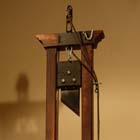 |
|
unjuried, risk-taking, independent performing arts |
Capital Fringe Festival 2008!
THE GIRL IN THE IRON MASK by R.L. Nesvet
Directed by Andrew Wassenich
Fight Direction by Cliff Williams, III
Featuring Heather Whitpan, Kelley Slagle, Tina Segovia, Umoja Rufaro, Amy Quiggins,
Lindsay Kitt Wiebe, Kelsey Rae Grouge and Catherine Aselford.
|
When royal twins are born, one must disappear. Through her own daring, and with
help from a dashing aristocrat and a sword-slinging nun, the lost princess roars
back from her anonymous prison to take her rightful place on the throne.
|

En Garde!
Friday, July 11 at 9:30 pm;
Thursday, July 17 at 9:00 pm;
Saturday, July 19 at 12:00 noon;
Monday, July 21 at 5:00 pm;
Saturday, July 26 at 5:30 pm
At the Universalist National Memorial Church, 1810 Sixteenth Street, NW.
|
The Girl in the Iron Mask is a swashbuckler by R.L. Nesvet, the author of The
Conjurer Meets The Devil and The Temple Of The Soul. Originally from the
Washington D.C. Metropolitan area, Nesvet interned with The Georgetown Theatre
Company as a teen in the winter of 1997; we are excited to bring this "home-grown"
playwright back to D.C. audiences.
|
click here to see production photographs
click here to see a video clip
More about this adaptation:
Emerging playwright R.L. Nesvet has adapted Afro-French novelist Alexandre Dumasí
The Man In The Iron Mask to explore female empowerment in response to the male
marginalization of women, while respecting Dumasí own recurring concerns with an
individualís loss of status and loss of connection to his/her father.
Although he ultimately broke through such barriers, Dumas himself was excluded
from mainstream opportunities due to his fatherís status as the illegitimate son
of a nobleman and an Afro-Caribbean slave. Dumas saw his father, a General of
the colorblind French Revolution, disgraced and impoverished by Napoleon Bonaparte.
The early death of his heroic father haunted Dumasí writings. The absence of
the deceased father becomes even more poignant in Nesvetís theatrical adaptation;
in The Girl in the Iron Mask, the heroine Louise never knows her father because
she is rejected as member of the royal caste and separated from her family at
birth due to her gender. In Dumasí original work, one of the Kingís twin sons
must disappear, while in Nesvetís play, the female twin must disappear. Louiseís
rescue comes through female agency; a former guard of Louiseís mother discovers
Louise as a prisoner in the Bastille. This sets in motion a reunion between
Louise, her mother and the now-retired sword-wielding female guards. These
powerful women attempt to restore Louise and create a just state ruled by a w
oman, a state offering freedom and opportunity to people of both genders and to
the people of color enslaved in Franceís overseas colonies.
Produced in part by a grant from The Arch and Bruce Brown Foundation of Palm Springs California.
|
|
|



